|
|
|
Arts and Paintings of Rajasthan |
|
Arts
of Rajasthan
Rajasthan is among the richest states in the country as
far as the field of art and craft is concerned. Today,
various varieties and artistry can be seen in the
various forms of paintings. The two main forms of
paintings are the formal school of miniature paintings
that flourished in courts all over India and Deccan and
the folk traditions that resulted in a unique style of
the painting of Rajasthan. The history of Rajasthan also
revealed that the kings and their nobles were patrons of
art and crafts and they encouraged their craftsmen in
activities ranging from wood and marble carving to
weaving, pottery and painting. May be it was the result
of the war which sharpened the creative senses, artistic
skills which inspired the craftsmen of Rajasthan to
create the most opulent and richest of treasures. Stone,
clay, leather, wood, ivory, lac, glass, brass, silver,
gold and textiles |
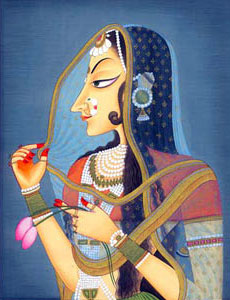 |
|
|
were given
the most brilliant forms. For women there was infinite variety
- tie and dye fabrics, embroidered garments, enamel jewellery
inlayed with precious and semi-precious stones, leather jootis
etc.
Sculptural Art of Rajasthan
Just as Rajasthan is known for the fine quality of its
paintings, it is also known for its great body of sculptures.
The sculptural art is one of the most profuse forms of
decorative art in Rajasthan, particularly in the medieval
period and was lavished in palaces and forts, temples and stepwells, and the havelis or townhouses of the merchants and
traders. The main tools of the mason or sculptor were basic
and crude, and included the tanki or punch, the pahuri or
chisel, the hathora or hammer, and the barma or borer. The
main used these simple elements, and followed the texts
designed especially for his use (Shipashastra and Manasara) to
build the perfect jharokha or arch or pillar. The texts are
very exhaustive on details and the individual expression of
creativity is permitted. There are two ways to examine the
issue of the sculptor’s art as an architectural embellishment,
and as stand-alone work. The stand alone art was very little
used in Rajasthan, and figures were carved either for
enshrining in temples, or sculpture was part of the great
design of architecture. |
|
|
|
Religious icons were always carved from marble and the
Makrana marble mines supply the marble for centuries.
Even today, in most of the shrines in India, the
religious images are carved in Jaipur where religious
iconography has developed into a fine art. But Jaipur is
merely a centre for creating marble images. For sheer
details, there is nothing to beat the excessive marble
sculpturing developed by the Jains at their temples.
Most of the Jain temples have large statues of their
trithankaras enshrined in the sanctum. The best examples
of Jain temples in Rajasthan are in Mount Abu and
Ranakpur. Mount Abu’s Dilwara temples contains four
principal shrines and are housed together. These temples
were built between the 11th and 12th centuries and used
all the administrative skills. The Ranakpur Jain temples
are one of the most beautiful temples raised by the
Jains in India. At the heart of the complex is the
temple of Adinath, one of the largest, most extensive,
and characterized by its excess and profusion of
sculpture. The temple has 29 halls supported by 1444
pillars. Not one of these pillars are alike in one way
or other and entirely sculptured with arabesques,
motifs, and statues.
Jain
temple architecture is characterized by its
|
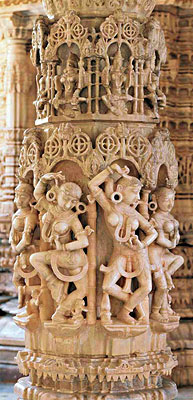 |
|
|
profusion of
sculpturing. The stone is moulded, chiseled, scooped
out, and developed so that each grain becomes a part of the
grand design of the temple. Nor is the work limited to a
similar repetition: pillars can be carved differently so there
is no one that is similar to another; each of these is alive
with images of gods and goddesses, musicians and dancers, and
there are architectural embellishments of such amazing
fluidity that it is impossible to disassociate architecture
from sculpture. The Jains also provided the basis for the
flowering of sculptured architecture in Jaisalmer. The Jains
were very rich and lived in the havelis, which were more royal
than the king's palace. They used sandstone in the havelis.
Some of the famous havelis in Jaisalmer are Nathmalji ki
Haveli, Patwon ki Haveli and Salim Singh’s Haveli. These
havelis were built in the 18th and 19th centuries by the
Muslim masons. These masons developed a body of sculptued
architecture that was not repeated elsewhere and also used the
expression, so that each mansion was like a textbook on the
subject. Fluted columns, balconies, arches, domes, jharokhas,
eaves, brackets and cupolas were carved very differently. Two
stone mason brothers were so adapted to their task that their
names, Hathu and Lalla, are still recorded in the annuals of
Indian art. While statuary as a part of architecture, and
geometrical and floral expressions, found a reflection in all
part of Rajasthan, the sculptors of Barmer, found creative
expression in their rich arabesques on the red sandstone.
Barmer continued to remain, one of the prime centres for
sandstone carving in the state.
Paintings of Rajasthan
Various Muslim artists worked in the Rajput courts, and Hindu
artists worked in the Mughal court. The Chittorgarh court also
offered employment to the Muslim painter and had a seminal
school in the 16th century from where a collection of Gita
Govinda paintings may have originated. Due to this, the Mewar
school become one of the most important schools in the state.
The Mughal artists of Delhi were welcomed by the rulers of
Rajasthan due to the decline of their patronage in the Mughal
court. As a result of it the Rajasthani school of paintings,
murals and miniatures came into existence in the 16th century.
In Rajasthan, from 16th to the 18th century, about seven
styles of painting developed over a period of time, and in
different kingdoms. The miniature paintings also flourished
before the establishment of the 16th century Mughal studios,
particularly as illustrations for manuscripts, and Akbar also
hired various court painters from Hindu kingdoms in North
India. The miniature painting is a portfolio painting that
uses techniques similar to wall paintings, cloth paintings or
manuscript illustrations from which it may have evolved. These
paintings are painted on a paper that has been specially
treated, and uses vegetable and mineral colours. Some of the
examples of the miniature paintings can be seen in the Mughal
and Rajasthani styles that existed in the 16th century. The
Mughals miniature paintings were restricted to court scenes
and portraits of the emperors and the rulers like Akbar,
Jahangir and Shah Jahan and also derived inspiration from
them. While, the Rajasthani school of miniatures was
characterised by a revival based on its increasing contact
with the Mughal Durbar. Various strong colours, bold
compositions, the range of hues almost passionate in their
intensity, and in their response to the life of the people,
ornamental depiction of nature and accentuated human forms
were used in the Rajasthan miniatures that reflect the Rajput
culture. |
|
|
|
The
main difference in the paintings was in the way the
painter looked at the countryside, hills, shrubs, forts,
gardens and sand dunes. The miniature paintings were
made on the variety of subjects like the kings,
religious and secular. But, their main subject was the
description of the Krishna Leela. In the Gita Govinda,
the miniature paintings also became a lyrical symbol
with swaying lotuses, meandering streams, and trees
suggesting the intimate passions of lovers. The epics
like the Ramayana and Mahabharata formed as the base for
religious works of art. Later, shades of royal lifestyle
came to be seen on the canvas of the painters, and
ranged from hunting scenes to ladies playing chess, or
polo.
Earlier, the finest miniatures used to be painted on
ivory, but it is now banned in India. The same artists
also tried to bring the same effect on marble but
|
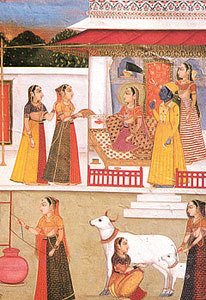 |
|
|
achieved very
less success. The painting on marble looks like the gesso work
from Bikaner that can be seen on the camel hide. Most of the
artists also used walls to create paintings, and a profusion
of work can be seen in the palaces of most of the kingdoms
where every walls and ceilings are lavished with scenes from
the Krishna Leela, or the exploits of Lord Rama, or the court
scenes and portraits of rulers. In aristocratic homes, the
secular and religious scenes were presented. Frescoes
paintings can be seen on the walls of palaces at Jaipur,
Udaipur, Bikaner and Jodhpur. Most of these paintings have the
themes of the Krishna stories, Raslila and Hindu religious
subjects.
Today, miniatures are turned out in almost
every studios that have been especially developed to help in
the tourist souvenir trade. These studios can be seen in
Jaipur, Udaipur and Kishangarh. Even now, the talent is
available in plenty, but the best artists rarely finds their
way in the open market. They are commissioned directly, and
their work can be seen as the collections, or used to
illustrate prestigious art books. Most of these works are
copies of earlier paintings, and original subjects are very
hard to find.
Folk Styles of Painting
While the formal school of miniatures were patronised by the
royal families and the aristocracy, the humbler settlements
patronised the humble forms of art and were very expressive.
The folk paintings used fabric as the material and emerged in
two styles. These two folk styles of painting are Phads and
Pichwais.
Phads
Phads are scroll-like paintings on a giant canvas that were
used by the Bhopa ministers to recount the legends of Pabuji
Ramdeo of the Rabari tribe, and his black mare. The tales are
painted in flaming orange, red and black colour in comic-strip
fashion. There is very little detailing and the expressive use
of the outline of human figures and the sketchy filling of the
background creates a lively tapestry. |
|
|
|
Pichwais
Pichwais are decorative curtain cloths used as a background
for religious images in a shrine. These can be brocaded block
printed, embroidered, or worked in gold threads. In the
simplest form, they can be secular in nature, and are painted
in huge quantities for sale to tourists. The Pichwai developed
when the Vallabhaichari sect created 24 iconographic rendering
as a background for the Krishna image at Nathdwara. Each of
these images were linked with a particular festival or
celebration. While images from Nathdwara are instantly
recognizable in the way Krishna is painted, and in the
decorative element that embellishes the cloth, the traditional
pichwai consist of starched, handspun cloth painted |
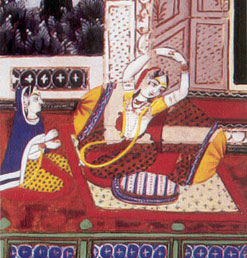 |
|
with vegetable and mineral colours like
cochineal, indigo, lapiz and orpiment. Nowadays, the fabric
colours are used. The format of the pichwai is static, where
even the natural elements appear ‘frozen’. The elements like
the sun, moon, stars, or even lighting appeared in the
painting.
Royal Styles of Painting
The Rajasthani miniature painting evolved various styles that
can be seen in the different kingdoms where it found
patronage. The miniature paintings were initially used as
illustrations for texts, and later evolved as portfolios of
the life and times of their royal patrons. In Rajasthan, there
are seven distinctive styles of Rajput paintings, and later
they evolved in the seven states which are Bikaner, Bundi and
Kota, Kishangarh, Jaipur, Mewar.
Bikaner:
One of the finest schools of miniatures was developed in
Bikaner. These paintings existed from 1600 onwards and show a
marked Mughal influence. In fact, the local style kept pace
with the painters in the Mughal court, and were not
expressive, while the Bikaneri artist tended to be more
expressive. The delicate sub colours were used and there was a
delicacy in the portrayal of human and vegetation forms. The
Mughal and Bikaneri miniatures were sometimes mistaken with
each other, as the pleasant background, colourscapes and the
foliage (as if to make up for the desert conditions), were
very luxuriant.
Bundi and Kota:
The Bundi and Kota school developed two different identities,
but have the same common identities. The Mughal intervention
blended the two traditions of illustrating court scenes. The
human figures appeared to have a haunting appearance, and were
not marked by formal austerity. The early works were the
commissions for illustrating traditional texts like Ragamala
and Rasikapriya. The hunting scenes captured the fancy of the
artist. As the school developed, it evolved into an entire
school of its own from 1700 onwards. The paintings have a
green tint and idealized the landscape and forestscape. The
feminine grace in group of young women leading to works is
very colourful, and creatively handled in the paintings. In
the Bundi school, the background usually consists of thick
foliage, with a sky over laden with clouds and illuminated by
the light of the setting sun. The architectural background is
equally impressive, with palaces and apartments depicted in
fine details. There is a lyrical expression of love that can
be seen in the paintings, and ornamental backgrounds. The same
style evolved in Kota, but it developed its own expression in
a similar and independent form. |
|
|
|
Kishangarh:
The Kishangarh artists were very brilliant and there is
nothing that matches their brilliance that lasted only
for a short while. Kishangarh was a Rathore kingdom, and
their early work was similar to that of the Marwar. A
more advanced style later replaced this in the first
quarter of the 18th century, and reached a point of
perfection under the rule of Savant Singh, the heir to
the throne of Kishangarh who finally abdicated in favour
of his son and chose to live a hermit’s life in
Brindavan. Under Savant Singh’s rule, the Nihal Chand,
one of the finest painters of the period and a school of
paintings dealing with Krishna and his lady love, Radha,
emerged. It is believed that the figures of Krishna were
modeled on Savant Singh , and those |
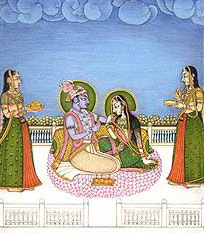 |
|
|
of Radha were
modeled on his mistress, known as Bani Thani. The portraits of
Bani Thani are among the most attractive miniatures in India,
and she obviously inspired Nihal Chand to cast her as Radha in
his Ras Leela scenes. The Kishangarh figures are exceptionally
attractive, and show a refined delicacy. The backgrounds
shared the elaborate style of Mughal paintings, together with
the use of the evening light, but the artists used a greater
expression of creative freedom. The Kishangarh paintings are
among the finest body of arts that were expressed in a canvas
of such elaborate colours.
Jaipur:
The Jaipur school of miniatures, which is still active, was
also the most formal school of miniatures. It was a kin to the
Mughal in the backgrounds, and in the court settings, but its
subjects were more secular. Of all the schools in Rajasthan,
Jaipur’s use of colours is the most understated. The depiction
of the human figure, by the 18th century, had been perfected.
The faces are accentuated, the eyes are large and curving, the
turbans are worn high, and while they sit or stand or ride,
the men are shown with a sense of vibrant energy. Even
paintings showing rulers practicing religious rituals are not
devoid of this quality of vibrancy. The background is more
characteristic with thick, rich decorative leaves of trees,
and skies are
enriched with thick, rolling clouds. Aniline colours too are
an important feature.
Mewar:
The Mewar school of painting is one of the largest school of
miniature paintings in Rajasthan. These miniature paintings
were found in Udaipur, from the 17th to 19th century. The main
theme of these paintings was the traditional text that ranges
from the Ragamala, Nayika-bhada and Krishna Leela to the
Ramayana and the Bhagvata Purana. The scenes from the Krishan
Leela came to be known for their amorous quality. One of the
first definitive sets of Ragamala paintings of 1605, and
executed by painter Nasiruddin, can be still seen in the
collections at Udaipur. The Mewar school is known for its
strong colours and decorative designs. The landscape has been
emphasized so that the human figures tend to integrate with
it. The decorative features were further accentuated with
Mughal cross fertilization when a mosaic-like, decorative
character evolved, due to foliage. Later, lifestyle portraits
were developed in the Sisodia school, replacing nature with
the background of the palaces of the Ranas. |
|
|
|
 |
|